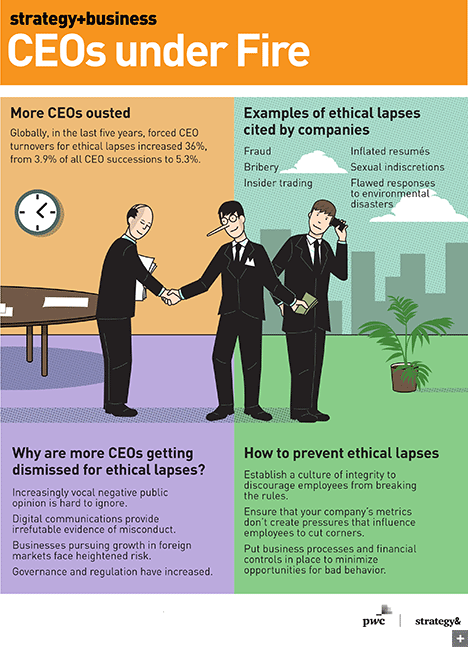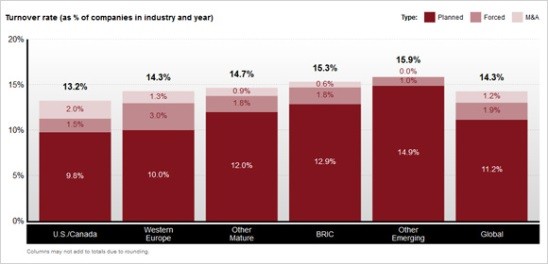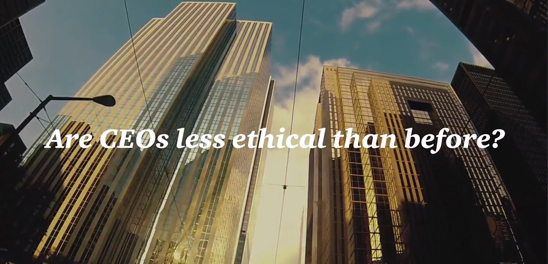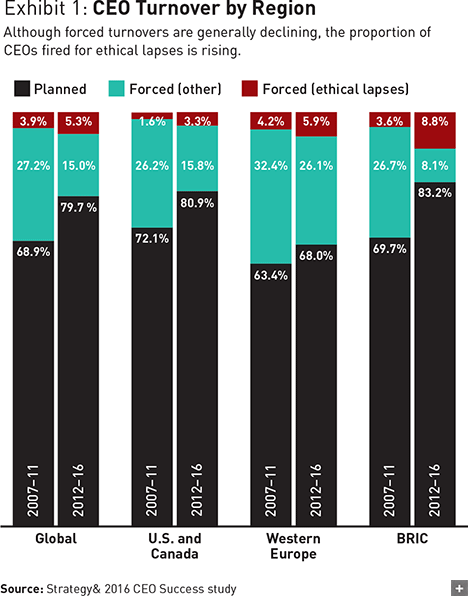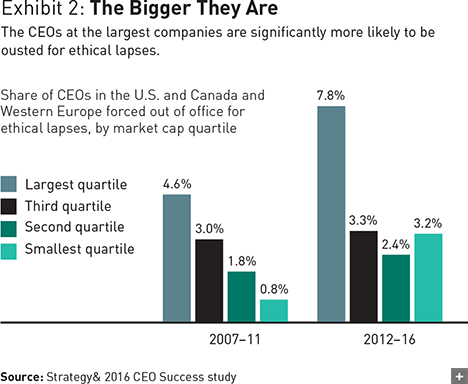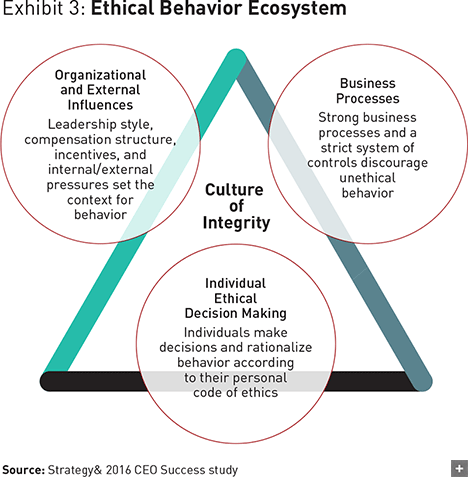Are CEOs less ethical than in the past?
Why more chief executives are losing their jobs after scandals and corporate misconduct. See also “CEOs under Fire.”

The job of a chief executive officer at a large publicly held company may seem to be quite comfortable — high pay, excellent benefits, elevated social status, and access to private jets. But the comfortable perch is increasingly becoming a hot seat, especially when CEOs and their employees cross red lines.
As this year’s CEO Success study shows, boards of directors, institutional investors, governments, and the media are holding chief executives to a far higher level of accountability for corporate fraud and ethical lapses than they did in the past. Over the last several years, CEOs have often garnered headlines for all the wrong reasons: for misleading regulators and investors; for cutting corners; and for failing to detect, correct, or prevent unethical or illegal conduct in their organization. Some high-profile cases, involving some of the world’s largest corporations, have featured oil companies bribing government officials and banks defrauding customers.
To be sure, the number of CEOs who are forced from office for ethical lapses remains quite small: There were only 18 such cases at the world’s 2,500 largest public companies in 2016. But firings for ethical lapses have been rising as a percentage of all CEO successions. (We define dismissals for ethical lapses as the removal of the CEO as the result of a scandal or improper conduct by the CEO or other employees; examples include fraud, bribery, insider trading, environmental disasters, inflated resumes, and sexual indiscretions. See “Methodology,” below.) Globally, dismissals for ethical lapses rose from 3.9 percent of all successions in 2007–11 to 5.3 percent in 2012–16, a 36 percent increase. The increase was more dramatic in North America and Western Europe. In our sample of successions at the largest companies there (those in the top quartile by market capitalization globally), dismissals for ethical lapses rose from 4.6 percent of all successions in 2007–11 to 7.8 percent in 2012–16, a 68 percent increase.
Our data cannot show — and perhaps no data could — whether there’s more wrongdoing at large corporations today than in the past. However, we doubt that’s the case, based on our own experience working with hundreds of companies over many years. In fact, our data shows that companies are continuing to improve both their processes for choosing and replacing CEOs and their leadership governance practices — especially in developed countries.
But over the last 15 years, the environment and context in which companies operate has changed dramatically as a result of five trends. First, the public has become more suspicious, more critical, and less forgiving of corporate misbehavior. Second, governance and regulation in many countries has become both more proactive and more punitive. Third, more companies are pursuing growth in emerging markets where ethical risks are heightened, and relying on extended global supply chains that increase counterparty risks. Fourth, the rise of digital communications has exposed companies and the executives who oversee them to more risk than ever before. Finally, the 24/7 news cycle and the proliferation of media in the 21st century publicizes and amplifies negative information in real time.
Add it all up, and you get greater scrutiny of CEO behavior, a greater desire for swift justice and action, and a smaller margin of error for all parties involved. But there’s good news for CEOs, their leadership teams, and their boards. Organizations can protect themselves by making sure that their controls and compliance programs are truly world-class, and — even more important — that their corporate culture sends and reinforces clear, well-understood messages about ethical conduct.
Room for Improvement
Globally, this year’s study shows that although there is still room for improvement, boards continue to get better at planning smooth successions and bolstering corporate governance. Over the last decade, the number of forced turnovers has dropped significantly. From 2007 to 2011, forced turnovers accounted for 31.1 percent of total turnovers at the 2,500 largest companies, whereas from 2012 to 2016 the share of forced turnovers fell sharply, to 20.3 percent. Our data also shows that the concentration of power in a single person is declining: The share of incoming CEOs who also serve as chair of the board at the world’s 2,500 biggest companies has been dwindling steadily, from 48 percent in 2002 to 10 percent in 2016.
However, dismissals for ethical lapses increased significantly over the last five years — on a global basis and in each of the three major regions we analyze: the U.S. and Canada; Western Europe; and Brazil, Russia, India, and China (the BRIC countries). The share of all successions attributable to ethical lapses rose sharply in the U.S. and Canada (from 1.6 percent of all successions in 2007–11 to 3.3 percent in 2012–16), in Western Europe (from 4.2 percent to 5.9 percent), and in the BRIC countries (from 3.6 percent to 8.8 percent; see Exhibit 1).
We believe that the rising numbers of dismissals for ethical lapses in the U.S. and Canada and Western Europe stem from the fact that the changes in the business environment we’ve cited — in public opinion, governance and regulation, operating risk, digital communications, and media attention — are most pronounced in those regions. The fact that dismissals for ethical lapses were even higher at companies in the top quartile by market capitalization in these regions supports that hypothesis, because the largest companies are the ones most affected by these changes and are subject to the greatest scrutiny (see Exhibit 2).
The higher rate of dismissals for ethical lapses in companies in the BRIC countries reflects these changes as well, but in an amplified way, given the historical pervasiveness of corruption in the countries in which these companies operate. Among the BRIC countries, for example, Transparency International’s Corruption Perceptions Index 2016 ranked Brazil, India, and China in 79th place (tied) out of 176 countries analyzed, and Russia was in 131st place.
Despite the global increase in dismissals for ethical lapses, companies in the U.S. and Canada have the lowest incidence of such dismissals — 3.3 percent in 2012–16, compared with 5.9 percent in Western Europe in 2016, and 8.8 percent in the BRIC countries. More stringent governance regulation is one likely reason. Nearly two-thirds of U.S. respondents to PwC’s Global Economic Crime Survey 2016, for example, agreed strongly that their organization had a code of conduct in place covering key risk and policy areas and setting out the organizational values and behaviors expected of employees, compared with 44 percent of respondents globally. And only 14 percent of U.S. respondents reported that their organization had experienced cases of bribery and corruption over the preceding 24 months, compared with 24 percent globally. Both the legislative requirements for codes of conduct and anti-bribery statutes have been tightened significantly in the United States.
When we compared the reasons for dismissal of CEOs who also held the title of board chair with the reasons for dismissal of those CEOs who did not hold both titles, we found that 24 percent of CEOs with joint titles were dismissed for ethical lapses, compared with 17 percent of those with the CEO title only — a 44 percent difference. This suggests that awarding joint titles to the CEO increases the risk of ethical lapses, and validates the consensus among experts that separating the roles is a basic tenet of good governance practice.
We also found that CEOs forced out of office for ethical lapses had a median tenure of 6.5 years, compared with 4.8 years for CEOs forced out for other reasons. Why? It’s possible that companies with long-serving CEOs tend to be those that have been achieving above-average financial results, and thus may attract less shareholder and media scrutiny than companies that have been performing poorly. It’s also possible that when an organization’s leadership is static, employees may begin to see ethical lapses as normal, and allegations of misconduct are less likely to be raised, investigated, or acted on.
A Sea Change in Accountability
How much has the level of CEO accountability risen in recent decades? In the late 20th century, even the most serious, large-scale, and widely publicized cases of corporate misbehavior rarely led to dismissal of the CEO. Criminal prosecutions of corporate officers were extremely rare. Financial penalties tended to be modest, ranging from the tens of millions to the low hundreds of millions of dollars, and media attention was often limited to the business press. Today, the chief executive of a company caught up in a major scandal is often dismissed quickly. And it is not uncommon to see multiple criminal indictments of corporate officers. The financial penalties that companies face have rocketed — in some recent cases, into the tens of billions of dollars. And media attention, from online outlets, cable television channels, and the relentless glare of social media, is omnipresent. We believe that the five tectonic shifts identified above have forged this new era of CEO accountability.
Public opinion. Confidence and trust in large corporations and CEOs have been declining for decades. But the decline has accelerated since the financial crisis of 2007–08, the Great Recession, and the slow recovery that ensued. Corporations and executives received government bailouts, while seeming to suffer little in the aftermath. Although many companies paid large fines and settlements, few were charged criminally, even in instances where unethical and illegal activity was widespread and well documented. Media attention has also focused more and more on corporate tax avoidance and the offshoring of jobs, as well as record-high rates of executive compensation and rising income inequality in general. Those are the areas that, although not illegal, do not promote goodwill.
The upshot: Only 37 percent of people consider CEOs credible today, according to the 2017 Edelman Trust Barometer — an all-time low for the 17-year-old survey, and down 12 percent from just last year. According to a long-running Gallup poll, whereas 34 percent of citizens surveyed in the U.S. in 1975 said they had “a great deal” or “a lot” of confidence in big business, only 18 percent said so in 2016.
Governance and regulation. Heightened public criticism and skepticism of executives and corporations have translated directly into regulatory and legislative action. Over the last 20 years, new laws — generally passed after scandals or market crashes — have ratcheted up scrutiny of CEOs and corporations and mandated much more formal and extensive compliance practices. In the U.S., the Sarbanes-Oxley Act of 2002, enacted in the wake of the Enron and WorldCom scandals, fundamentally changed the nature of corporate regulation, and similar measures were enacted in many other countries. The Dodd-Frank Act of 2010, which imposed new regulations and standards, included further measures to detect, discourage, and punish corporate wrongdoing. To keep on the right side of such laws, companies in the U.S. and many other countries have moved to a zero-tolerance approach toward bad behavior in the C-suite.
Today, the CEO of a company caught up in a major scandal is often dismissed quickly.
One effect of these measures has been to shift the focus of accountability from companies to individuals. Indeed, prison sentences for corporate malfeasance have been increasing. Between 1996 and 2011, the mean fraud sentence for individuals in U.S. federal courts nearly doubled — from just over one year to almost two years. During the same period, the mean sentence for all federal crimes dropped from 50 to 43 months. (It’s worth noting that a debate is currently under way in the U.S. about whether business regulation has become overly stringent, potentially signaling an inflection point in the trend toward increased corporate oversight.)
In recent decades, power has also shifted away from CEOs and toward boards and large shareholders. The days of an “imperial CEO” presiding over a board largely composed of personal friends and company insiders are gone. In 2016, according to the Spencer Stuart Board Index, 85 percent of all board directors at S&P 500 companies were independent, and 27 percent of boards had a truly independent chair, up from 9 percent in 2005.
Business operating environment. The threats that companies face in the normal course of business have multiplied in recent decades. Global growth opportunities are increasingly found in emerging economies, where the risk of ethical lapses — particularly corruption and bribery — is higher than in more developed markets, in terms of both complying with local legal systems and meeting home-country legal requirements for global operations. Not surprisingly, the percentage of CEO turnovers resulting from ethical lapses is much higher in the BRIC countries than in other regions in our study.
The growing interconnectivity of businesses, as operations have globalized and supply chains have lengthened, also exposes companies to more risk. Companies don’t only have to worry about risk in their own business. They also have to be cognizant of the risks present in their vendors, and in the vendors of their vendors.
The rise of digital communications. Beyond providing new channels for indiscretion, the use of email, text messaging, and tweets has created new risks for ethical lapses. A company’s digital communications can provide irrefutable evidence of misconduct, and their existence increases the likelihood that a CEO will be held accountable for ethical lapses that occur on his or her watch. A public company CEO who tweets inaccurate information about the company, for example, puts him- or herself at risk for being investigated by the SEC for securities fraud.
Moreover, society’s rising reliance on data and digital technologies — including the rapidly emerging Internet of Things — has outpaced the development of systems, standards, rules, and other measures for mitigating the risks to cybersecurity and privacy that are inherent in the many devices being designed, built, purchased, and used online. Hackers have succeeded in accessing the private data and electronic communications of companies and executives with the goal of exposing unethical or embarrassing conversations and conduct to the public and media.
The 2016 Global State of Information Security Survey found that the number of these types of security incidents across all industries rose by 38 percent in 2015 — the biggest increase in the 12 years since the global study was first published. In the 2017 edition of the survey, 59 percent of respondents reported having raised their cybersecurity spending as a result of digitizing their business ecosystem.
The 24/7 news cycle. The changing nature of media has amplified negative news and opinion about businesses and executive conduct. In the 20th century, most executives and companies could maintain a low public profile, and live and work in relatively anonymity. No longer. The lightning-fast flow of Web-based financial news and data ensures that information travels quickly and widely. What’s more, negative information revealed by whistleblowers, short sellers, critics, and hackers quickly attains global distribution. Companies are now pressured to respond instantly when problems, crises, or inquiries appear in the news, erupt on social media, or arise directly from influential individuals. In this pressure-cooker environment, it’s easy for the removal of the CEO to become the public’s — and eventually the company’s — solution of choice.
Build a Culture of Integrity
Large organizations undoubtedly face a large and expanding spectrum of threats and issues. And the reality is that CEOs, senior leaders, and board members will increasingly be held accountable (often personally) for ethical lapses that occur anywhere in their organization. So how can leaders limit their exposure to potential threats?
From our own experience in advising companies that have experienced ethical lapses, we have observed that the single most important force for preventing fraud and other misconduct and withstanding regulatory scrutiny is your corporate culture. An effective culture must clearly state the company’s values of ethics and integrity, but it also needs to ensure that every team — and every employee — understands the critical few behaviors that will enable them to embrace and live those values in the work they do every day. To reinforce those behaviors, the company’s organizational ecosystem must address the underlying conditions that are always present when employees engage in illegal or unethical acts, by (1) ensuring that the company isn’t creating pressures that influence employees to act unethically; (2) making sure business processes and financial controls minimize opportunities for bad behavior; and (3) preventing employees from finding ways to rationalize breaking the rules. This line of thinking borrows from sociologist Donald Cressey’s classic 1950 conception of the “fraud triangle,” which identified the three elements necessary as precursors to fraud as opportunity, rationalization, and pressure (see Exhibit 3).
1. Organizational and external influences. Unethical behavior is typically triggered by some kind of pressure or incentive. Financial pressures (such as bonus packages or stock options) are often assumed to be the primary driver of bad behavior. But this is a misconception. Rather, social pressures tend to create larger problems. Employees and managers may be unwilling to admit they can’t meet performance targets. An organization that prides itself on never missing a quarterly earnings target, for example, may inadvertently create this kind of pressure. Companies can inoculate themselves from such concerns by taking the following three steps:
• Recognize whether you have a “command and control” culture. You may be inadvertently encouraging bad conduct. Companies that get caught in ethical lapses typically have incentives that prioritize achieving targets over all else, exposing managers and employees to pressures that discourage speaking up to deliver bad news or flag ethical issues.
• Insist on an open-door policy. Are you encouraging your managers and employees to raise issues that trouble them in informal dialogue, rather than only on formal occasions such as performance reviews?
• Consider whether you need structural reform. If your company has an excessively purpose-driven culture that reflects a strong or charismatic CEO modeling the wrong approach, do you need a stronger governance infrastructure at the board level to act as a check and balance? Part of the remediation may be one-on-one coaching to help the CEO develop an appropriate tone.
2. Business processes. Weak business practices or lax financial controls create opportunities for unethical behavior. Most large companies in developed countries have robust financial controls, and these have been strengthened over the last two decades by the requirements of the Sarbanes-Oxley Act in the U.S. and similar laws elsewhere. Make sure your processes and controls are strong and up-to-date by following three steps:
• Determine your unique threat profile. Are you aware of the full range of potential threats that exist in places you operate or plan to operate, and the political and economic climate in those places? Consider all third parties to which you may have exposure.
• Take a close look at your existing compliance program. Are your current controls sufficient to mitigate the threats across all operations? They should be updated and tested to deal with any changes to your business strategy, your operating model, and the laws and regulations spanning your geographic footprint.
• Assess your employee reporting systems. Is an employee hotline or similar feedback mechanism in place that employees can use to ask questions or discreetly report issues — and if so, are your employees aware of it?
3. Individual ethical decision making. Employees who break the rules must first convince themselves that their actions are justifiable, a process known as rationalization. In some cases, they feel they have no alternative if they are to keep their job or meet their performance targets. In other cases, they convince themselves that their conduct isn’t really wrong, or that it is justified because the organization’s culture or leadership implicitly condones it. Companies can understand this process and prevent it from taking root by taking the following three steps:
• Clarify your communications strategy. Is the compliance and ethics messaging from the top clear and consistently understood across the organization, and is the messaging and training frequent enough and adapted to local languages and cultural nuances?
• Drive engagement from the top. Are the leaders’ behaviors consistent with what they say in their communications? Are senior leaders and managers reinforcing messages about ethical conduct by engaging with their direct reports and staff? Sharing stories about difficult situations and how they were resolved — and not shying away from those that turned out badly — is one of the most powerful ways to inculcate awareness of what not to do. Some leadership teams publish case studies with transcripts of emails that show how mistakes happen. Leadership teams should also engage “informal” leaders, individuals who lack formal authority but who lead through example, experience, or reputation, to communicate and amplify key messages throughout the organization.
• Don’t go it alone. Do leaders and managers have access to informed advice? In some cases, ethical lapses occur because individuals facing ethical dilemmas act without fully understanding how the decisions they make relate to the rules — and this is especially likely in crises. When in doubt, seek guidance from experts either inside or outside the firm.
The low level of public trust and confidence in big business may be dismaying. But it’s the reality in which companies operate today. We believe that public perceptions may not fully reflect the extent to which legal, regulatory, and ethical standards now in effect have evolved from those of earlier times. In a perverse way, the increasing incidence of CEO dismissals for ethical lapses may have a positive effect on public opinion over time — by demonstrating that bad behavior is in fact being detected and punished.
In the meantime, the only course for CEOs who wish to avoid being part of the small but rising share of leaders dispatched for ethical lapses, and for their board colleagues, is to lead by example. Talking the talk is necessary. But it’s not sufficient in this unforgiving climate. On a personal level, that means telling the truth, seeking advice and following it, and responding swiftly to any allegations of misconduct. On an organizational level, that means working to ensure that your company’s processes and controls are effective in all the businesses and geographies in which you operate, and striving to build and maintain a true culture of integrity.
CEO Turnover in 2016
Turnover among CEOs at the world’s 2,500 largest companies decreased from its record high of 16.6 percent in 2015 to 14.9 percent in 2016, due largely to a drop in merger and acquisition activity. Our turnover data reaffirms the continuing improvement in corporate governance globally: Planned turnovers, which are generally indicative of good succession planning, continue to be more common. Excluding CEOs removed as a result of M&A, the share of planned turnovers in 2016 was 81 percent, the third-highest rate since 2000. This was the seventh year in a row that the share of planned turnovers was more than 75 percent.
Another sign of improving CEO succession practices: The share of incoming CEOs who were also named board chairman was just 10 percent in 2016 — up slightly from 7 percent in 2015, but far lower than the 25 to 50 percent rates of the early 2000s.
Women CEOs
Globally, companies appointed 12 women CEOs in 2016 — 3.6 percent of the incoming class. This marks a return of the slow trend toward greater diversity that had been occurring over the last several years, and a recovery from 2015’s 2.8 percent. Of the regions studied, the share of incoming women CEOs was highest in the U.S. and Canada, rebounding to 5.7 percent after having fallen for the previous three years. China had the second-highest share of incoming women CEOs, at 5.3 percent. Among industries, utilities companies had the highest share of incoming women CEOs, at 13.6 percent, followed by consumer discretionary (7.3 percent) and financial services (5.4 percent). However, five industries — healthcare, industrials, information technology, consumer staples, and telecom services — did not have a single incoming woman CEO in 2016.
Regions, Industries, Demographics
CEO turnover was highest in Brazil, Russia, and India, at 17.2 percent, followed by Japan (15.5 percent), Western Europe (15.3 percent), and China (15.2 percent). CEO turnover fell in every region we studied except for the U.S. and Canada. Turnover was lowest, at 13.6 percent, in emerging countries other than BRIC, and second-lowest in the U.S. and Canada, at 14.2 percent. The spread between the highest and lowest regional succession rates was unusually narrow.
Among industries, turnover in 2016 was highest at utilities companies, where more than one-fifth of all companies — 20.8 percent — appointed a new CEO; this was followed by industrial companies (16.4 percent) and energy companies (16.1 percent). For the first time in five years, telecom services did not have the highest rate of CEO turnover.
The share of incoming CEOs with international work experience continued to decline, to 24 percent in 2016 from 28 percent in 2015. Western European companies were most likely to hire CEOs with international work experience; 47 percent of incoming CEOs there had worked in other regions. And a large majority of companies continue to choose CEOs from the same country as the location of their company headquarters — 87 percent in 2016, up from 83 percent in 2015.
Thirty-six percent of the incoming class of 2016 had MBA degrees, the highest share in the last five years. The share of incoming CEOs with Ph.D.s was little changed, at 10 percent, as was the median age of 53. The number of CEOs hired from outside the company, however, fell to its lowest level in five years: 18 percent, down from 23 percent in 2015.
Methodology
The CEO Success study identified the world’s 2,500 largest public companies, defined by their market capitalization (from Bloomberg) on January 1, 2016. We then identified the companies among the top 2,500 that had experienced a chief executive succession event between January 1, 2016, and December 31, 2016, and cross-checked data using a wide variety of printed and electronic sources in many languages. For a listing of companies that had been acquired or merged in 2016, we also used Bloomberg.
Each company that appeared to have changed its CEO was investigated for confirmation that a change occurred in 2016, and additional details — title, tenure, chairmanship, nationality, professional experience, and so on — were sought on both the outgoing and incoming chief executives (as well as any interim chief executives). Company-provided information was acceptable for most data elements except the reason for the succession. Outside press reports and other independent sources were used to confirm the reason for an executive’s departure.
Finally, Strategy& consultants worldwide separately validated each succession event as part of the effort to learn the reason for specific CEO changes in their region. To distinguish between mature and emerging economies, Strategy& followed the United Nations Development Programme 2015 ranking. Total shareholder return data over a CEO’s tenure was sourced from Bloomberg and includes reinvestment of dividends (if any). Total shareholder return data was then regionally market adjusted (measured as the difference between the company’s return and the return of the main regional index over the same time period) and annualized.
Reprint No. 17208
Author profiles:
- Per-Ola Karlsson leads the organization, change, and leadership practice in the Middle East for Strategy&, PWC’s strategy consulting business. Based in Dubai, he is a partner with PwC Middle East.
- DeAnne Aguirre is the global leader of the Katzenbach Center of Innovation for Culture and Leadership and an expert in team effectiveness for Strategy&. Based in San Diego, she is a principal with PwC US.
- Kristin Rivera leads PwC’s fraud risk and controls team and serves as the global forensics clients and markets leader. A partner with PwC US, she is based in San Francisco.
- Also contributing to this article were Gary Neilson, Spencer Herbst, and Anjali Fehon, of PwC US, and s+b contributing editor Rob Norton.


